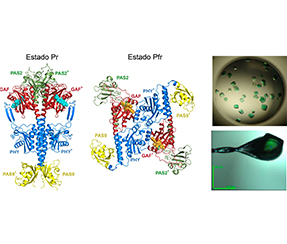Light is an environmental key that gives living organisms temporal-spatial information essential for their survival. Photoreceptors are the molecules in charge of sensing the light signal and internalizing that information inside the cell. Although they were initially discovered in plants and animals, they were later discovered in the rest of the Kingdoms and Domains of Life, including bacteria and archaea.
Regarding their biological role, it has been observed that bacterial photoreceptors are involved in modulating the interaction of the bacterium with its host both in symbiotic relationships, as is the case of Rhizobium leguminosarum, and in parasitic relationships on plants such as Xanthomonas campestris and Pseudomonas syringae and on animals such as Brucella abortus, Acinetobacter baumannii and Burkholderia multivorans.
Photoreceptors are proteins that absorb light of wavelengths within the visible range through the binding of small molecules called chromophores, usually with aromatic groups. In particular, bacterial photoreceptors are multidomain proteins. They have at least two modules, a photosensor module and an output module. Various types of photosensor modules exist in nature, which absorb far-red, red, yellow, green, blue and UV light. On the other hand, the most abundant output domains in prokaryotes belong to the following families: histidine kinases, PAS, phosphatase, diguanylate cyclase. Although there is considerable sequence and structural conservation at the domain level, a great diversity of combinations of sensor modules and output modules is observed.
The light controls through the photosensor module the activity of the output module. A central question in the field of bacterial photoreceptors is how light sensing is coupled to the output domain activity. The scope of this question extends to other sensor proteins (of other physical and chemical environmental cues). Because many bacterial photoreceptors are soluble and relatively easy to obtain, they have become model molecules. Additionally, the knowledge in this field allows thinking about strategies to solve agronomic and human and animal health problems.
On the other hand, very successful molecular tools based on photoreceptors have been developed for the last 20 years. This discipline known as Optogenetics consists of coupling photosensor modules to different proteins of interest to make them photoregulated. In this sense, the study of photoreception in bacteria undoubtedly provides information relevant to Optogenetics.
We are also interested in understanding at the Biological and Microbiological level what are the cellular events downstream of the photoreceptors, what proteins, metabolites and genes are involved, what biological processes are regulated by light and by photoreceptors, how light and photoreceptors intervene in interaction with the host.
Our experimental models are B. abortus, R. leguminosarum, and X. campestris, for which we have knock-out strains for the photoreceptors under study, both single and double mutants. We also planned to incorporate M. colombiense. We will focus on two families of photoreceptors, the blue light receptors of the LOV protein family and the red light receptors of the phytochrome family.
On the other hand, we propose to use both groups of photoreceptors to design optogenetic tools.
Ongoing projects
Molecular basis of the red light signaling pathway in Rhizobium leguminosarum

Group leader
Jimena Rinaldi
PHD student
Addys Nuñez Garbizo

Jimena Rinaldi
Group Leader
CONICET Adjunct Researcher.
She graduated in Biological Sciences from the Faculty of Exact and Natural Sciences of the University of Buenos Aires in 2003. She completed her PhD in 2009 under the supervision of Dr. Silvia Moreno de Colonna in the Department of Biological Chemistry from the same Faculty.
Mail: jrinaldi@unsam.edu.ar